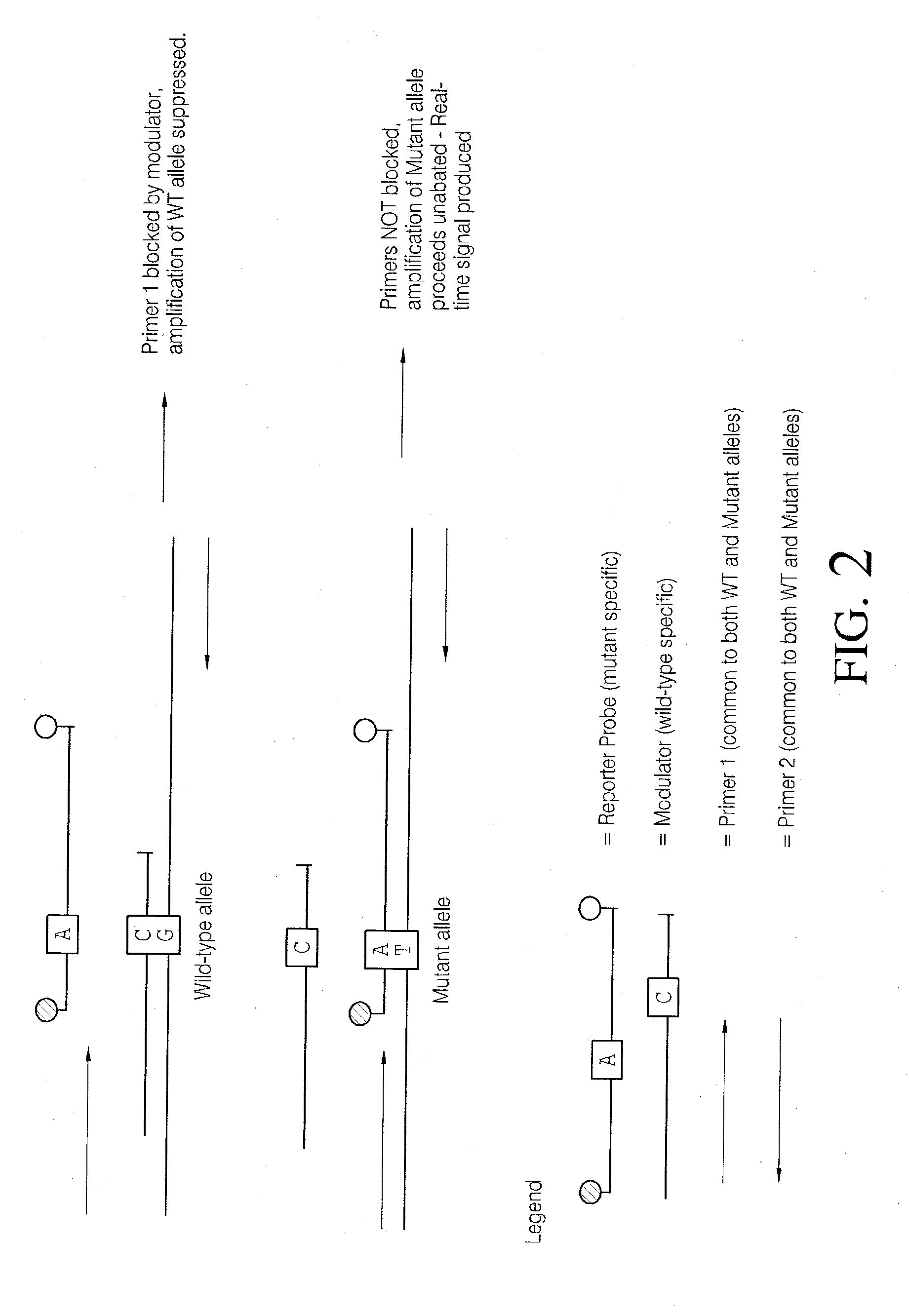Methods and compositions for modulation of amplification efficiency
- Summary
- Abstract
- Description
- Claims
- Application Information
AI Technical Summary
Benefits of technology
Problems solved by technology
Method used
Image
Examples
example 1
[0129]The following example demonstrates that the methods disclosed herein can be used to effectively detect multiple rare variant target allele sequences in samples comprising an excess (100 fold or more) of wild-type or alternative variant or mutant target allele sequences.
[0130]KRAS allelic variants G34T, G34C, G34A, and G38A, which are commonly used in the diagnosis prognosis of various cancers, as well as predicting the sensitivity of tumors to certain therapeutics, were used as an exemplary system to demonstrate the efficacy of the methods described herein. FIG. 11 shows the target region of interest in KRAS, including the wild-type sequence, as well as the position of the G34A, G34T and G38A variants.
[0131]Shown in FIG. 11 are three different amplification primers, i.e., Primer 1.0, Primer 1.2 and Primer 1.3 designed to amplify the target region of interest. Also shown are four different modulator / blocker oligonucleotides, i.e., blocker oligonucleotide 1.4, blocker oligonucle...
example 2
[0135]The following example demonstrates how the methods disclosed herein can be used to detect methyl cytosine residues in the death associated protein-1 (DAPK-1) promoter region. Changes in methylation status within the promoter region of DAKP-1 are frequently associated in with a variety of types of cancer and therefore accurate assessment of methylation patterns can be an important diagnostic indicator (Raval et al., (2007), Cell, 129: 879-890; Candiloro et al Epigenetics 2011 6: 500-507).
[0136]FIG. 13A shows a 105 bp target sequence within the promoter region of DAKP-1. CpG sites, which are often the sites of altered cytosine methylation patters, are shown in boxes. FIG. 13A also shows the unique sequences generated following treatment of the DAKP-1 promoter target sequence, when the sample DNA is originally fully unmethylated, or fully methylated. Specifically, as shown, there are nine cytosine residues that are potentially methylated, and that would be resistant to bisulphite...
example 3
[0139]FIG. 14 illustrates the relative target binding positions of the two primers, KERLA-tcdB 40 and KENP-tcdB 41, two probes, NK-toxB-B34-AD 42 and Sign-B4-B0 43, and three modulator oligonucleotides, KERLA-Mod1 44, KERLA-Mod2 45, and KERLA-Mod3 46, relative to the Clostridium difficile toxin B gene target 47 and internal control sequence 48. The three modulator oligonucleotides, KERLA-Mod1 44, KERLA-Mod2 45, and KERLA-Mod3 46, differ with respect to their melting temperatures (relative to the target) and the degree of overlap with the target binding region of the upstream amplification primer KERLA-tcdB 40 to the Clostridium difficile toxin B gene target. The sequences for these three alternative modulators are listed in FIG. 15, and their characteristics are listed in Table 2. The modulator oligonucleotides described in Table 2 attenuate amplification of the internal control sequence of a model PCR-based assay for detection of the toxin B gene of C. difficile. Table 2 lists the ...
PUM
| Property | Measurement | Unit |
|---|---|---|
| pH | aaaaa | aaaaa |
| pH | aaaaa | aaaaa |
| pH | aaaaa | aaaaa |
Abstract
Description
Claims
Application Information
 Login to View More
Login to View More - R&D
- Intellectual Property
- Life Sciences
- Materials
- Tech Scout
- Unparalleled Data Quality
- Higher Quality Content
- 60% Fewer Hallucinations
Browse by: Latest US Patents, China's latest patents, Technical Efficacy Thesaurus, Application Domain, Technology Topic, Popular Technical Reports.
© 2025 PatSnap. All rights reserved.Legal|Privacy policy|Modern Slavery Act Transparency Statement|Sitemap|About US| Contact US: help@patsnap.com



